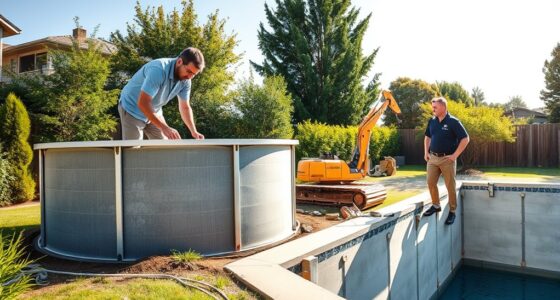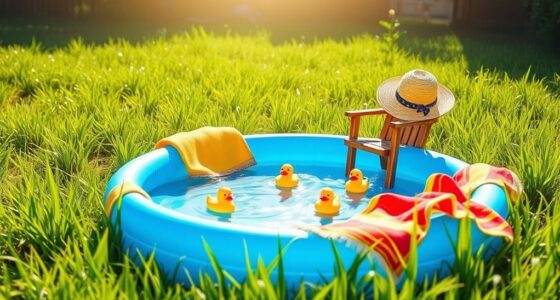To troubleshoot algae prevention quickly, start by checking your water circulation and filtration to verify they’re working properly and that water flows smoothly. Test and balance your water chemistry, keeping pH and sanitizer levels in the ideal range. Inspect lighting to prevent shaded spots and remove organic debris regularly. Adjust algaecide levels and trim overhanging vegetation to reduce shaded areas. Consistent surface cleaning and routine maintenance are key—you’ll find simple steps to keep algae at bay as you explore further.
Key Takeaways
- Ensure proper water circulation and clean filters to prevent stagnant spots that promote algae growth.
- Regularly test and adjust water chemistry, maintaining optimal pH, alkalinity, and sanitizer levels.
- Inspect and replace faulty lighting, and trim surrounding vegetation to reduce shaded areas where algae thrive.
- Remove organic debris weekly using nets, brushes, and surface cleaning to cut nutrient sources for algae.
- Use algae control treatments and maintain good water flow to inhibit algae spores and prevent further growth.
Check Water Circulation and Filtration Systems
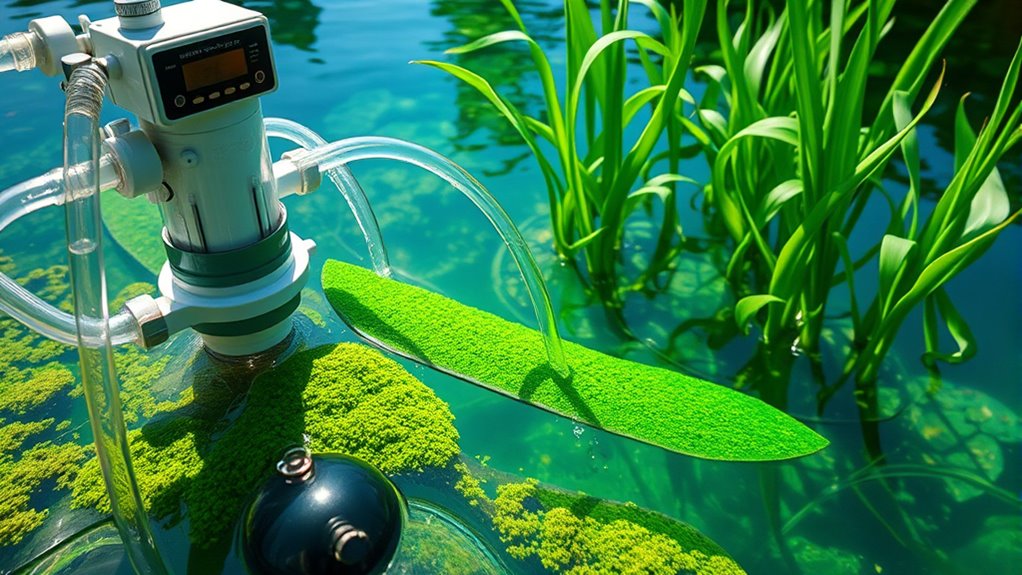
Ensuring proper water circulation and effective filtration is vital for preventing algae growth. When water flow is consistent, nutrients and waste are evenly distributed, reducing algae-favorable spots. Check that your pump is functioning correctly and that the water moves smoothly throughout the system. Poor water flow can lead to stagnant areas where algae thrive. Additionally, guarantee your filter operates at maximum efficiency; a clogged or outdated filter hampers water clarity and promotes algae buildup. Regularly clean or replace filter media to maintain peak performance. Proper circulation and filtration work together to keep your pool water clear and balanced, making it less inviting for algae to take hold. Staying vigilant with these systems is a simple yet critical step in algae prevention.
Test and Balance Water Chemistry
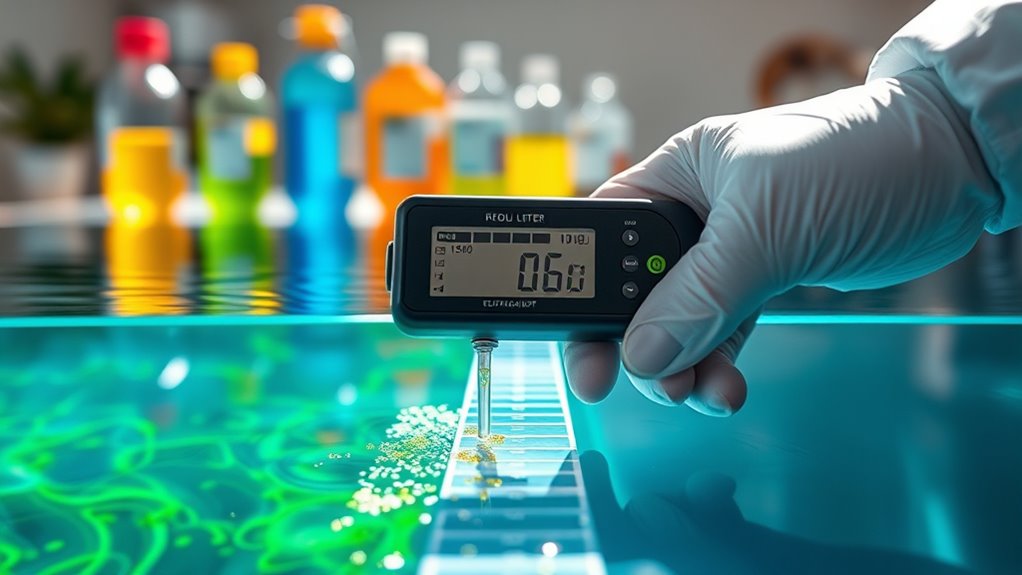
After confirming your water circulation and filtration are working properly, it’s time to focus on testing and balancing your water chemistry. Regular water testing helps you identify issues with pH, alkalinity, and chlorine or other sanitizer levels. Proper chemical balancing keeps algae at bay and maintains water clarity. Use test kits or digital testers to check key parameters:
| Parameter | Ideal Range |
|---|---|
| pH | 7.2 – 7.6 |
| Alkalinity | 80 – 120 ppm |
| Chlorine | 1 – 3 ppm |
Adjust chemicals accordingly to stay within these ranges. Consistent water testing and chemical balancing ensure your water remains inhospitable for algae growth, saving you time and effort in algae prevention. Cost‑of‑ownership considerations can also help you choose the most effective methods for long-term water chemistry management.
Inspect and Adjust Pool or Pond Lighting

Inspecting and adjusting your pool or pond lighting is essential because improper lighting can promote algae growth and reduce water clarity. Verify underwater fixtures are functioning correctly and are not creating uneven illumination, which can encourage algae to thrive in shaded areas. Check that aquatic plants aren’t blocking or shading lights, as this can create dark spots where algae can develop. Replace any damaged or malfunctioning underwater fixtures to maintain consistent lighting throughout the water. Proper lighting discourages algae by allowing you to monitor and control algae-prone zones effectively. Keep lights at appropriate depths and ensure they’re not overly bright or dim, as both can impact algae growth. Regularly inspecting your lighting setup helps maintain a healthy, clear aquatic environment. Understanding the role of algae in water quality can help you better identify and address potential issues early.
Remove Organic Debris Regularly
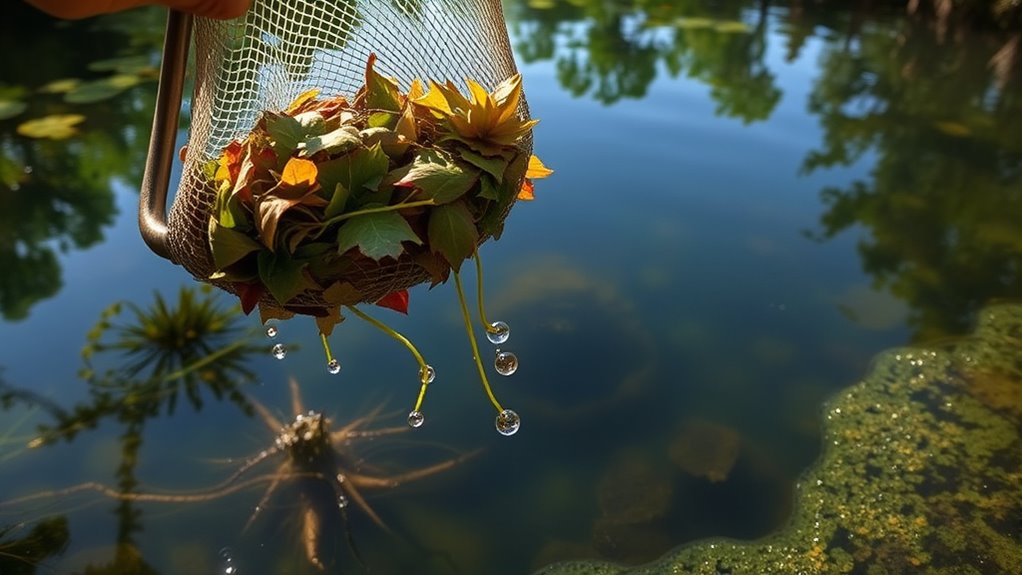
You need to keep the area around your pool or pond clear of debris to prevent algae growth. Regularly remove fallen leaves and rinse the pond weekly to reduce organic matter. Maintaining a tidy environment makes it harder for algae to take hold and flourish. Incorporating vertical storage solutions for tools and supplies can help keep your workspace organized and efficient.
Clear Surrounding Area
To effectively prevent algae growth, it’s vital to regularly clear the area around your pond or water feature of organic debris. Organic material like twigs, leaves, and plant clippings can decompose, releasing nutrients that feed algae. A thoughtful landscape design can help minimize debris buildup by incorporating features such as mulch or barriers. Additionally, maintaining proper water aeration ensures oxygen circulation, which discourages algae-friendly conditions. Trim overhanging branches that drop debris into the water and keep the surrounding area tidy. Proper water management practices can also reduce nutrient input and help control algae growth. By actively removing debris and optimizing landscape elements, you reduce nutrient input and create an environment less conducive to algae growth. Consistent maintenance of the area around your pond is a simple yet effective step in algae prevention.
Remove Fallen Leaves
Regularly removing fallen leaves from your pond or water feature is essential to prevent algae growth. Fallen leaves and other organic debris can decompose, releasing nutrients that fuel algae. By promptly clearing these materials, you reduce nutrient buildup and inhibit algae blooms. Use a pond net or scoop to remove debris frequently, especially during autumn when leaves fall abundantly. Keep in mind:
- Organic debris accelerates algae growth
- Fallen leaves can block sunlight penetration
- Regular removal helps maintain water clarity
- Reducing debris minimizes nutrient levels in your pond
- Employing proper filtration systems can further aid in controlling algae proliferation
Consistent cleanup prevents algae from thriving, keeping your pond clear and healthy. Don’t wait for algae to appear—stay proactive by removing fallen leaves and organic debris regularly. This simple step is key to effective algae prevention.
Rinse Pond Weekly
Rinsing your pond weekly is an effective way to keep organic debris in check and prevent algae growth. Regular pond rinsing helps remove leaves, algae, and other organic matter that can decay and fuel algae blooms. By actively clearing debris, you reduce nutrient buildup that algae thrive on, supporting algae prevention efforts. Use a pond net or filter to gently remove floating debris and rinse your pond surfaces as needed. Incorporating proper wig care and styling techniques can also help prevent the introduction of contaminants that promote algae growth. Consistent pond rinsing ensures your water stays clear and healthy, making it harder for algae to establish. Remember, keeping organic debris under control is key to effective algae prevention.
Examine and Maintain Algaecide Levels
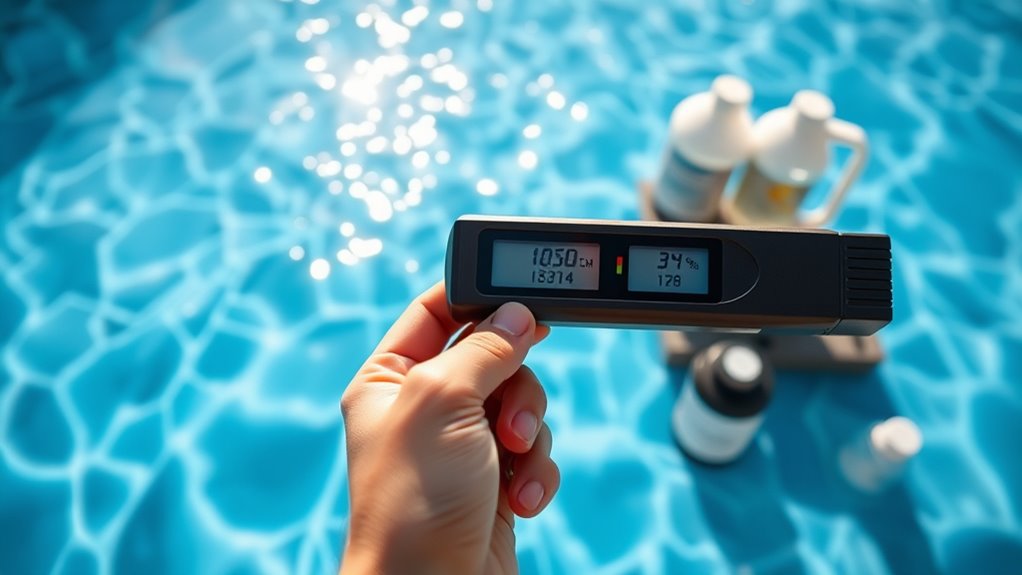
Maintaining proper algaecide levels is essential for effective algae prevention, and you should regularly check these levels to guarantee they stay within the recommended range. Proper chemical testing helps ensure your algaecide dosage is accurate, preventing over- or under-treatment. To keep algae at bay, follow these key tips:
- Conduct routine chemical testing to monitor algaecide levels accurately
- Adjust algaecide dosage based on test results and pond size
- Use a reliable testing kit for consistent readings
- Reapply algaecide as needed, especially after heavy rain or sunlight exposure
- Utilizing professional voiceover techniques when creating instructional videos can improve clarity and engagement for users learning about pond maintenance
Consistently maintaining the right algaecide balance prevents algae blooms and keeps your pond clear. Remember, proper testing and dosage are crucial to an effective algae prevention strategy.
Identify and Address Shaded Areas

First, check for any objects or structures blocking sunlight from reaching the water. Trim back overgrown vegetation that casts shade over the pond or pool. Ensuring proper sunlight exposure helps prevent algae from thriving in shaded areas. Additionally, maintaining proper water quality through filtration and chemical treatment can further inhibit algae growth.
Assess Light Obstructions
To effectively prevent algae growth, it’s essential to identify areas where light is obstructed, as shaded zones can promote algae by limiting sunlight exposure. These shaded areas often create stagnation and reduce water circulation, making them prime spots for algae to thrive. When evaluating light obstructions, look for:
- Overhanging trees or branches blocking sunlight
- Structures casting shadows over the pond or pool
- Nearby vegetation that shades parts of the water
- Debris or algae buildup creating shaded spots
Addressing these obstructions improves sunlight exposure, discouraging algae development. Ensuring even sunlight penetration helps maintain healthy water conditions and prevents algae from gaining a foothold. Regularly checking for and removing light barriers is a simple but effective step in algae prevention. Additionally, understanding the role of light in algae growth can help you better manage and prevent future issues.
Trim Surrounding Vegetation
Since shaded areas encourage algae growth by limiting sunlight, it’s important to identify and trim overhanging vegetation around your pond or pool. Pruning overgrowth and trimming bushes reduce shaded spots, promoting better water circulation and sunlight exposure. This discourages algae from thriving in low-light conditions. Use the following table to determine which vegetation to trim:
| Vegetation Type | Location | Action Needed |
|---|---|---|
| Overhanging trees | Near water edges | Prune back branches |
| Dense bushes | Surrounding pond | Trim to allow light |
| Tall grass | Pool perimeter | Cut back to improve flow |
Additionally, maintaining proper water circulation is essential to prevent algae buildup and keep your pond or pool clear.
Clean and Scrub Surfaces Thoroughly

Thoroughly cleaning and scrubbing surfaces is essential for preventing algae growth. Regular surface cleaning removes dirt, debris, and algae spores that can settle and promote growth. Pay special attention to areas prone to moisture buildup, as these are hotspots for algae. When cleaning, focus on effective stain removal techniques to eliminate any discoloration caused by algae or other contaminants. Use a stiff brush or scrubber to reach into crevices and textured surfaces. Consider using algae-specific cleaning solutions or diluted bleach for stubborn stains. Remember, the key is consistency—clean surfaces at least once a week.
- Remove organic matter that feeds algae
- Use appropriate cleaning tools for stubborn stains
- Disinfect surfaces to kill spores
- Rinse thoroughly to prevent residue buildup
Establish a Consistent Maintenance Routine
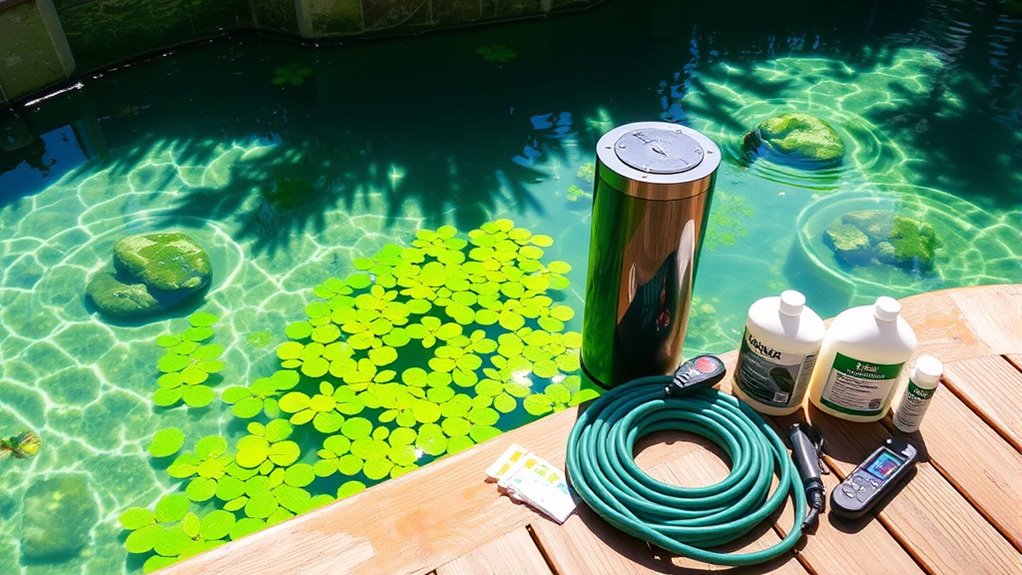
Establishing a consistent maintenance routine is essential for long-term algae prevention. Regular checks help you maintain proper chemical balancing, which is vital for algae prevention. You should test your water frequently to confirm pH, alkalinity, and sanitizer levels stay within ideal ranges. Consistent chemical balancing prevents conditions that algae thrive in, reducing their growth. Schedule routine cleaning of filters, skimmers, and surfaces to remove debris and prevent nutrient buildup. By sticking to a regular maintenance schedule, you catch issues early before they turn into major algae problems. Keep detailed records of your tests and maintenance activities to identify patterns and adjust your routine as needed. A disciplined approach ensures your water stays clear, healthy, and algae-free over time.
Frequently Asked Questions
Can Algae Spores Survive in Low-Light Conditions?
Algae spores can survive in low-light conditions because their longevity varies, allowing them to endure until conditions become favorable. Low light algae growth might be slow initially, but spores remain dormant and viable for long periods. To prevent algae, you need to control light exposure and nutrient levels. Even in dim environments, spores can reactivate when conditions improve, so consistent maintenance is key to effective algae prevention.
How Often Should I Replace My Pool or Pond Filters?
For flawless filtration, follow a routine of regular filter replacement—typically every 4 to 6 weeks, depending on usage. Consistent filter maintenance prevents particles from piling up, disrupting the algae lifecycle and promoting clearer water. Neglecting this vital step can lead to algae accumulation and cloudy conditions. Keep your pool or pond pristine by prioritizing prompt filter changes, ensuring efficient filtration, and staying ahead of algae’s invasive influence.
What Natural Remedies Help Prevent Algae Growth?
You can prevent algae growth with eco-friendly solutions and chemical alternatives. Use natural remedies like barley straw, which releases antioxidants that inhibit algae, and maintain proper water circulation and shading to prevent sunlight from fueling algae. Adding beneficial bacteria or enzymes helps break down nutrients that algae thrive on, reducing their growth naturally. Regular maintenance and these eco-conscious methods keep your pond or pool clear without relying on harsh chemicals.
Are There Specific Algae Types More Resistant to Treatment?
You won’t believe how stubborn some algae can be—it’s like fighting a never-ending battle! Certain algae types, especially resistant algae, showcase remarkable resilience against common treatments. These resilient strains often thrive in nutrient-rich waters and can withstand harsh conditions, making them tricky to eradicate. To outsmart algae resilience, you need targeted solutions tailored to specific resistant algae types, ensuring your prevention efforts are truly effective.
How Does Water Temperature Influence Algae Development?
Water temperature considerably influences algae growth; warmer water accelerates algae development, making it more challenging to control. When temperatures rise, algae reproduce faster, increasing the likelihood of blooms. You should monitor water temperature regularly and consider using shading or cooling methods to slow algae growth. Keeping water cool and stable helps prevent rapid algae proliferation, giving you a better chance to manage and prevent algae problems effectively.
Conclusion
By following these simple steps, you’ll master algae prevention faster than you can say “crystal-clear water.” Regular maintenance and quick inspections keep algae at bay and protect your pond or pool from turning into a green, slimy nightmare. Don’t let algae take over — with just a few minutes of effort, you can keep your water pristine and inviting. Take action now, and watch your aquatic space stay flawless for years to come!




